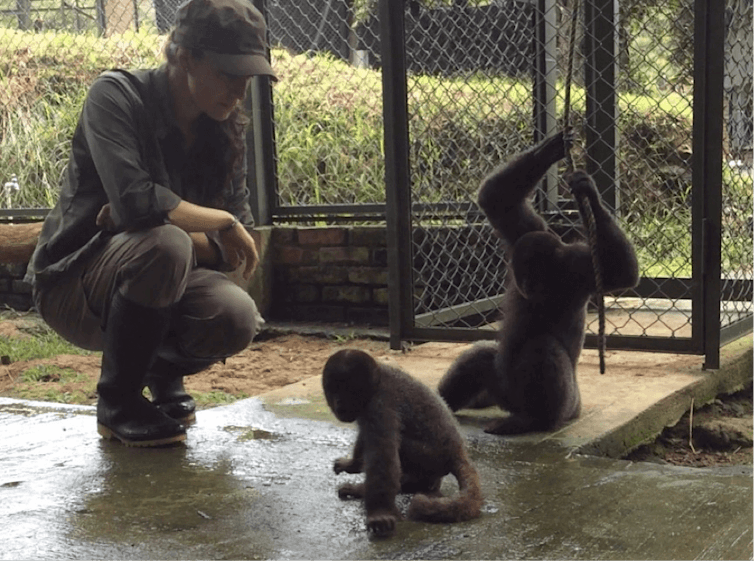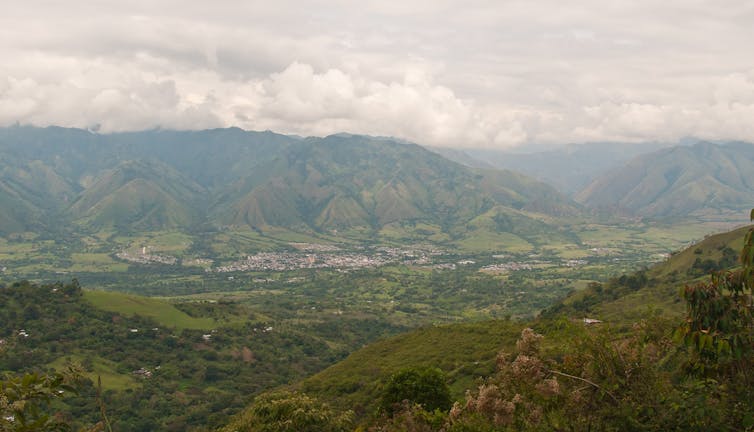We train Colombian woolly monkeys to be wild again – and maybe save them from extinction
- Written by Mónica Alejandra Ramírez, PhD Candidate on Primate Ecology, Universidad de los Andes
Colombia’s Andes Mountains used to be loaded with wildlife, including South America’s sole bear species, the spectacle bear, and the mountain tapir, which lives only in the world’s highest altitudes.
You couldn’t walk a mile in the jungle without seeing a woolly monkey – big, agile and charismatic primates with powerful long tails.
Now the species is hard to spot[1]. Over the past 50 years, habitat loss, poaching[2] and smuggling for adoption as pets[3] have all decimated Colombia’s woolly monkey populations. Andean woolly monkeys are at risk of extinction in the next century, scientists say. They have already disappeared entirely in some parts of Colombia[4].
Restoring Colombia’s jungles
To save the woolly monkey, Colombian wildlife[5] and environmental agencies[6] teamed up with scientists like us from the Laboratory of Tropical Forest Ecology and Primatology[7] at Colombia’s University of the Andes.
In August 2017, we released six captive woolly monkeys into the forests of southern Huila, about a 12-hour drive south of Bogota, the capital. This jungle-covered region was once home to many troops of these lovely primates. Now they’re conspicuously absent.
 A Colombian woolly monkey in captivity.
Tatiana Novoa, Author provided
A Colombian woolly monkey in captivity.
Tatiana Novoa, Author provided
We wanted to see if animals born in the wild, captured by traffickers and confiscated by Colombian authorities could learn to live there again.
Releasing animals who’ve spent time in captivity is risky. Often, they lack the behaviors necessary to survive in the wild[8], such as self-defense and bonding strategies.
According to a comprehensive review of wildlife reintroduction programs worldwide[9], only 26 percent are successful. Most either fail outright – the animals die – or do not last enough to evaluate the fate of the released animals.
To help us develop a training plan for promoting natural behaviors[10], we first spent over a year observing dozens of captive woolly monkeys at zoos and sanctuaries across Colombia.
We saw that many woolly monkeys had become comparatively clumsy climbers, and rather than seek out food they tended to wait for their caretakers to feed them. They had also lost the ability to spot and flee predators.
Hope for woolly monkeys
After a year of assessing their behavior, we chose 11 candidates for possible reintegration into the wild based on their reproductive viability, strength, health and non-attachment to humans.
During the six-month rehabilitation process, we used what we call “environmental enrichment” to instill survival skills among these woolly monkeys.
To reduce time spent lolling on the ground and encourage climbing, we placed the monkeys’ food high up on platforms simulated trees. We also promoted bonding by putting pairs of woolly monkeys together in “socialization cages,” which encourages them to groom each other and interact one-on-one.
 A scientist from the University of the Andes observing captive woolly monkeys as part of Colombia’s wildlife reintegration program.
Monica Ramirez, Author provided
A scientist from the University of the Andes observing captive woolly monkeys as part of Colombia’s wildlife reintegration program.
Monica Ramirez, Author provided
To boost predator response, we played sounds made by predators like eagles and jaguars, followed by other monkeys’ alarm cries, so that the captive woolly monkeys would learn to recognize them as a threat.
After the training period, the six fittest monkeys were released into the Huila forest reserve, an area with ample food and protection from hunters. Two were juveniles. Four were adults.
All wore collars that tracked their location and recorded their behavior to evaluate the monkeys’ adaptation process.
At first, we provided some food for the newly reintroduced monkeys. After five months they were weaned off entirely.
Cautious optimism
A year after the six monkeys were released, two had been recaptured because they were struggling to adapt, spending too much time on the forest floor and unwilling to bond with their troopmates.
Two had gone missing. And two died within months – one after falling from a tree and another of mysterious causes.
Admittedly, those aren’t great results.
We think the problem may have been the location. The Huila nature reserve has enough fruit to feed the monkeys, but it gets quite cold there. In low temperatures, your body uses a lot of energy to heat itself. Perhaps their self-feeding skills weren’t sufficiently developed for them to consume enough calories.
Group cohesion was also low in this cohort, causing some individuals to break away from their group – a dangerous thing to do in the jungle.
 The forests of Huila, Colombia, where the first cohort of rehabilitated woolly monkeys were released into the wild in 2017.
Jaime Hernando Duarte/flickr, CC BY[11][12]
The forests of Huila, Colombia, where the first cohort of rehabilitated woolly monkeys were released into the wild in 2017.
Jaime Hernando Duarte/flickr, CC BY[11][12]
Worth the effort
Our project shows how difficult it is to restore endangered primate populations.
But we need to keep trying. Over half of all Colombia’s 30 or so primates species[13] are in danger of going extinct, according to Diana Guzman[14], president of the Colombian Primatology Association.
Their demise would have severe environmental consequences. South American primates have been shown to eat, digest and disperse each day about 2 million seeds per square mile of habitat[15] – an important ecological service[16] for Colombia’s tropical forests.
Colombia does not have enough animal sanctuaries and zoos to house the thousands of primates recaptured from smugglers[17] every year. Many are euthanized, “reintroduced” into inappropriate habitats or even returned to the black market[18]. The lucky few that are taken into captivity often suffer from heart disease, obesity, behavioral disruptions and psychological damage[19] – disorders linked to a sedentary lifestyle and inadequate diet.
Comprehensive, long-term primate rehabilitation and reintroduction programs[20] like ours – which is funded by the Colombian government and the nonprofit Primate Conservation, Inc. – are costly. We spend about $5,000 per monkey resettled.
But rehabilitating and releasing seized animals is far cheaper, and way more environmentally appropriate, than keeping them behind bars for a lifetime[21]. And ours is one of the few primate reintegration programs of its kind in Latin America.
The next generation of woolly monkeys
In November 2018, we released our second cohort of six rehabilitated monkeys, including one female monkey recaptured last time.
This time, we chose the Rey Zamuro[22] nature reserve, in the Meta Colombia region. The jungle there has warmer weather and likely a greater food supply, and we are hopeful they can establish themselves there.
So far, the Meta Colombia troop seems to be doing well, particularly in group bonding.
We’ll keep checking in on them all year, learning from their experiences to help generations of rewilded woolly monkeys to come.
References
- ^ hard to spot (www.iucnredlist.org)
- ^ poaching (onlinelibrary.wiley.com)
- ^ smuggling for adoption as pets (www.bdigital.unal.edu.co)
- ^ disappeared entirely in some parts of Colombia (link.springer.com)
- ^ wildlife (www.cormacarena.gov.co)
- ^ environmental agencies (www.cam.gov.co)
- ^ Laboratory of Tropical Forest Ecology and Primatology (ecologia.uniandes.edu.co)
- ^ behaviors necessary to survive in the wild (link.springer.com)
- ^ a comprehensive review of wildlife reintroduction programs worldwide (www.sciencedirect.com)
- ^ promoting natural behaviors (www.ncbi.nlm.nih.gov)
- ^ Jaime Hernando Duarte/flickr (www.flickr.com)
- ^ CC BY (creativecommons.org)
- ^ 30 or so primates species (tropicalconservationscience.mongabay.com)
- ^ Diana Guzman (latinamericanpost.com)
- ^ 2 million seeds per square mile of habitat (www.mendeley.com)
- ^ ecological service (onlinelibrary.wiley.com)
- ^ the thousands of primates recaptured from smugglers (zslpublications.onlinelibrary.wiley.com)
- ^ euthanized, “reintroduced” into inappropriate habitats or even returned to the black market (www.nationalgeographic.com.au)
- ^ psychological damage (zslpublications.onlinelibrary.wiley.com)
- ^ primate rehabilitation and reintroduction programs (portals.iucn.org)
- ^ keeping them behind bars for a lifetime (greengarageblog.org)
- ^ Rey Zamuro (www.facebook.com)
Authors: Mónica Alejandra Ramírez, PhD Candidate on Primate Ecology, Universidad de los Andes

